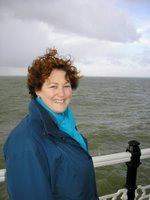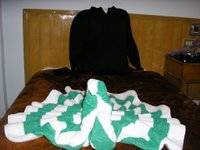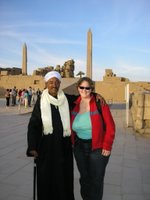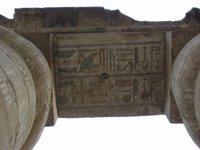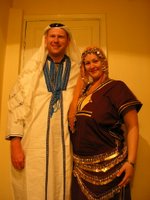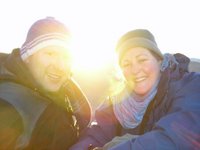Living it up in London - 30 May 2006
We’ve now been living in London for a month and have settled into a soothing routine of cycling, working, cycling, sleeping, cycling, working….
The whole cycling escapade began one fine Saturday when Maria popped out for some shopping while I was at work. She came and met me after work and we had a lovely evening out (we saw ‘Good Night and Good Luck’ – it is very good). It was when we arrived home later that night that I was surprised to find I could no longer open the apartment door. Maria had failed to mention the impediment to my usual sweeping entrance. It had two wheels, front suspension, lights, bells and whistles. A minor oversight on Maria’s part, forgetting to mention this particular purchase. Honestly, she is becoming so absent minded…
My part in the great adventure happened through a sustained campaign of propaganda. Maria began waxing lyrical over the beauty and tranquillity of a genteel ride through the parks of the West End. ‘Much nicer than rubbing shoulders with the great unwashed’ she gibed as she strapped on her helmet and sped into the distance every morning. Indeed, so enthusiastic was she that I agreed to participate in a riding tour of London the following Sunday afternoon. Not being one to indulge too enthusiastically in activities involving physical exertion, I was concerned that the ride would leave me utterly spent. Little did I know that the leisurely ride was to be the least of my exertions for that day.
Having finished our ride, and puffed up with my achievement of having ridden through Westminster unscathed and in apparent fine health, we made the bold step of hiring my admirable steed for a month to see whether I could become a fully-fledged member of the crazed two wheelers. Since I still had my doubts as to the long-term viability of my legs as a form of locomotion, this seemed like the sensible option. Deciding to take the bike that afternoon however began a series of dramas of Faustian proportions.
The bike hire shop is on the south bank of the Thames, not far from Waterloo International. As we wheeled the bike from subway to bus stop, we were educated in timely fashion as to the realities of taking bicycles on public transport. Busses were not an option. The underground is fine, as long as its not underground. Problem was, we were on the south side of town, and needed to get to the north-west side. Since we had neglected to bring our map (a glaring oversight in retrospect) I couldn’t ride the bike home. Maria offered to ride the bike home, but my bike is designed for those of great height, and the length of the journey would have given her altitude sickness. We finally discovered that we needed to take an overland train from Kings Cross. So Maria rode the bike to Kings Cross whilst I luxuriated on the bus. Maria beat me to Kings Cross, which just goes to prove that she can nearly torque the pedals off a bicycle!
Having reached Kings Cross and found the Thames-link station (which is not in Kings Cross), we discovered that the trains weren’t running. Go to Kentish town, they said. It’s not that far, they said. Catch the bus – oh, not you with the bike – you’ll have to ride there. And so, I hopped onto another bus and Maria, with a great degree of trepidation and in a fair bit of pain by now (her toes were the only things that touched the pedals, she tells me that isn’t a comfortable way to ride a bike), followed the bus to Kentish Town.
She kept up with the speeding bus quite well until she got a puncture. She managed to catch up to the bus without air in the back tyre just long enough to gain my attention by banging on the window. I alighted at the next stop, and without a clear idea of where we were, we endeavoured to follow in the bus’ wake, now carrying the bicycle because the tyre had dislodged from the rim and couldn’t be rolled. A decidedly unpleasant six kilometres later, we managed to ‘person-handle’ the bike onto a rather flash looking train. We certainly didn’t look flash by this point, but after a change onto the tube, arrived at Willesden Green and decided to celebrate our day of healthy endeavour with a Chinese takeaway meal that could have fed a family of ravenous Tasmanian Devils. Then we collapsed into a state near unto death, having exercised non-stop for nine and a half hours. Suffice it to say, we didn’t ride to work on Monday.
Fixing the puncture proved a more formidable challenge than one could have expected. Having extracted the offending bladder, Maria returned it to the hire shop during her lunch break, and brought home a new tube, and a maintenance kit including a small pump. A piece of advice for young players: valves on bicycle tubes here are very strange. The pump we had came with a useful lack of instructions, and after an hour of fruitless pumping, swearing and gesticulating, we ‘googled’ the bicycle valve and discovered the problem. The pump is designed to fit both major types of valve, and had a component which, unbeknown to us, could be reversed, thus allowing the alternative valve to be addressed. More swearing, pumping and gesticulating ensued, but this time the result was an inflated tyre, rather than a deflated ego. I was really getting to love the whole bicycle experience by this point.
The next day we started riding to work together. It takes us about fifty minutes to ride to work, and I feel pretty good when I get to work (with the not insignificant exception of my posterior, which is currently suing the rest of my body on the grounds of wilful neglect). It takes an hour to ride home however as there is an uphill section (not a big hill, just a gentle incline over 4 miles) that results in me switching to first gear and hardly moving despite considerable sweating and furious pedalling. It really is quite embarrassing being overtaken by a granny with a walking frame. The ride home has been compounded this last week by gale force head winds. In addition, the stability of the weather can only be described as ‘Melbournesqe’. A nice sunny day can turn into a squally mess faster than you can say ‘nah, I won’t need my Gore-tex!’ (As we have written this blog, the weather has changed from warm and sunny, to a hail storm, to a tropical downpour, and now its bright and sunny again).
And so I pedal to work, peddle my wares and then pedal home to my lovely petal. (Sorry, I just couldn’t resist.) And that’s about all that’s happening in our little world right now. London is in drought, with the wettest May on record. Ol’ Blighty is a strange place indeed. We shall write more after our sojourn in Bruges in two weeks time. Till then, take care, and we will attempt to do the same.
PS
We wrote this blog entry in Greenwich before attending a lecture at the Royal Naval Museum. The lecture was organised by the Flamsteed Astronomy Society (Flamsteed was the first Astronomer Royal) and the guest lecturer was the 17th Astronomer Royal, Sir Arnold Wolfendale. The lecture was on the origins of the universe, Sir Wolfendale being a specialist on background radiation. It was an incredibly entertaining lecture, with descriptions of the early universe (from 10-47s) sprinkled with anecdotes about meetings with Prince Philip and Margaret Thatcher. It has been a real highlight of our London experience thus far.
Fletch’s tip for new travellers
As a learned audience, I’m sure you all understand the difference between writing in first, second and third person. Whilst both Maria and I wrote this blog entry, it was written in the Fletch person, thus allowing a more consistent telling. The Maria person is nicer than me.

